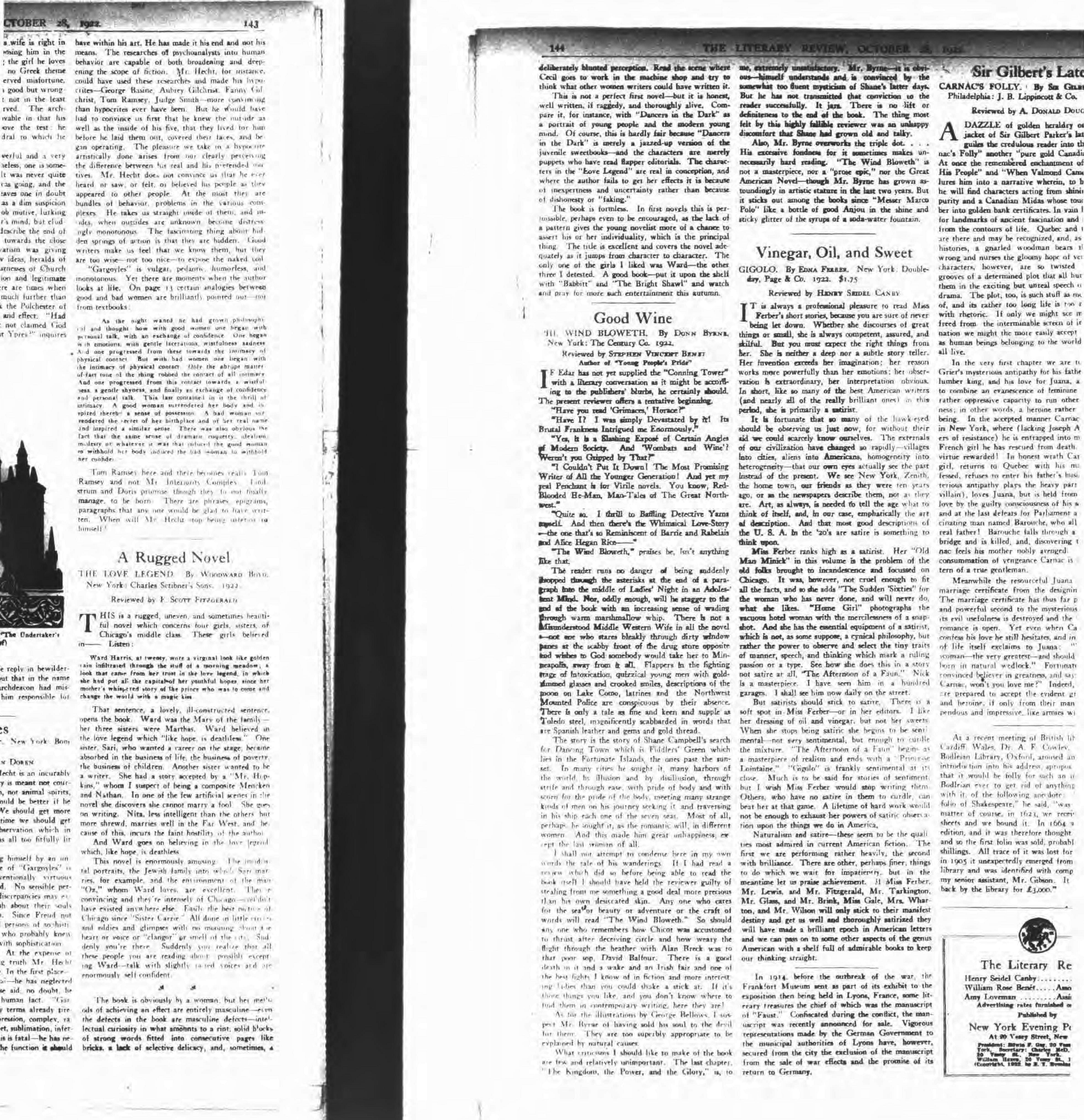
A Rugged Novel
by F. Scott Fitzgerald
The Love Legend. By Woodward Boyd.1 New York: Charles Scribner’s Sons. 1922. Reviewed by F. Scott Fitzgerald
This is a rugged, uneven, and sometimes beautiful novel which concerns four girls, sisters, of Chicago’s middle class. These girls believed in—— Listen:
“Ward Harris, at twenty, wore a virginal look like golden rain infiltrated through the stuff of a morning meadow; a look that came from her trust in the love legend, in which she had put all the capital of her youthful hopes, since her mother’s whispered story of the prince who was to come and change the world with a magic kiss.”
That sentence, a lovely, ill-constructed sentence, opens the book. Ward was the Mary of the family—her three sisters were Marthas. Ward believed in the love legend which “like hope, is deathless.” One sister, Sari, who wanted a career on the stage, became absorbed in the business of life, the business of poverty, the business of children. Another sister wanted to be a writer. She had a story accepted by a “Mr. Hopkins,” whom I suspect of being a composite Mencken and Nathan. In one of the few artificial scenes in the novel she discovers she cannot marry a fool. She goes on writing. Nita, less intelligent than the others but more shrewd, marries well in the Far West, and, because of this, incurs the faint hostility of the author.
And Ward goes on believing in the love legend, which, like hope, is deathless.
This novel is enormously amusing. The incidental portraits, the Jewish family into which Sari marries, for example, and the environment of the man “Oz,” whom Ward loves, are excellent. They’re convincing and they’re intensely of Chicago—couldn’t have existed anywhere else. Easily the best picture of Chicago since Sister Carrie.2 All done in little circles and eddies and glimpses with no mooning about the heart or voice or “clangor” or smell of the city. Suddenly you’re there. Suddenly you realize that all these people you are reading about—possibly excepting Ward—talk with slightly raised voices and are enormously self- confident.
The book is obviously by a woman, but her methods of achieving an effect are entirely masculine—even the defects in the book are masculine defects—intellectual curiosity in what amounts to a riot, solid blocks of strong words fitted into consecutive pages like bricks, a lack of selective delicacy, and, sometimes, a deliberately blunted perception. Read the scene where Cecil goes to work in the machine shop and try to think what other women writers could have written it.
This is not a perfect first novel—but it is honest, well written, if raggedy, and thoroughly alive. Compare it, for instance, with Dancers in the Dark3 as a portrait of young people and the modern young mind. Of course, this is hardly fair because Dancers in the Dark is merely a jazzed-up version of the juvenile sweetbooks—and the characters are merely puppets who have read flapper editorials. The characters in The Love Legend are real in conception, and where the author fails to get her effects it is because of inexpertness and uncertainty rather than because of dishonesty or “faking.”
The book is formless. In first novels this is permissible, perhaps even to be encouraged, as the lack of a pattern gives the young novelist more of a chance to assert his or her individuality, which is the principal thing. The title is excellent and covers the novel adequately as it jumps from character to character. The only one of the girls I liked was Ward—the other three I detested. A good book—put it upon the shelf with Babbit4 and The Bright Shawl5 and watch and pray for more such entertainment this autumn.
Notes
1. Woodward Boyd was the pen name of Peggy Boyd (1898-1965), who was married to Thomas Boyd. Fitzgerald had recommended The Love Legend to Maxwell Perkins at Scribners.
2. Theodore Dreiser’s 1900 novel.
3. This 1922 novel by Dorothy Speare (1898-1951) was set at a women’s college.
4. Sinclair Lewis’s 1922 novel about a midwestern businessman.
5. Joseph Hergesheimer’s 1922 historical romance set in the West Indies.
Published in The Literary Review of the New York Evening Post newspaper (28 October 1922).
Not illustrated.
